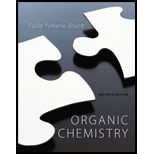
Concept explainers
(a)
Interpretation:
The products formed from the solvolysis of given compound in ethanol has to be drawn.
Concept Introduction:
Unimolecular nucleophilic substitution reaction in which the reversible ionization of
(b)
Interpretation:
The products formed from the solvolysis of given compound in ethanol has to be drawn.
Concept Introduction:
Unimolecular nucleophilic substitution reaction in which the reversible ionization of alkyl halide in the presence of aqueous acetone or an aqueous ethyl alcohol provides a carbocation as an intermediate, attacked by the nucleophile to form the product. If the leaving group in SN1 reaction is attached to the asymmetric carbon, a pair of enantiomers will be formed. An enantiomer, also known as an optical isomer, is one of two stereoisomers that are mirror images of each other that are non-superimposable.
(c)
Interpretation:
The products formed from the solvolysis of each following compounds in ethanol is to be drawn.
Concept Introduction:
Unimolecular nucleophilic substitution reaction in which the reversible ionization of alkyl halide in the presence of aqueous acetone or an aqueous ethyl alcohol provides a carbocation as an intermediate, attacked by the nucleophile to form the product. If the leaving group in SN1 reaction is attached to the asymmetric carbon, a pair of enantiomers will be formed.
An enantiomer, also known as an optical isomer, is one of two stereoisomers that are mirror images of each other that are non-superimposable.
Want to see the full answer?
Check out a sample textbook solution
Chapter 9 Solutions
Organic Chemistry
- Draw the products formed when ethylene oxide is treated with followingreagent. HBrarrow_forwardDraw the major product(s) obtained from the acid-catalyzed hydration of the following alkene: CH3CH2CH2CH=CH2arrow_forwardFor the following five reactions, draw the product(s) obtained from the cycloalkene and the reactant cocktails.arrow_forward
- What products are formed when the following compounds react with ozone and then with dimethyl sulfide?arrow_forwardWrite out the synthesis for each of the following reactions. Show the product and reagents for each step in each synthesis.?arrow_forwardDraw the products formed from LiAlH4 reduction of each compound.arrow_forward
